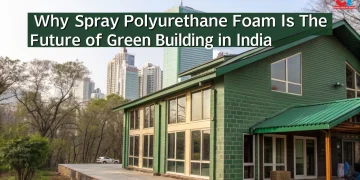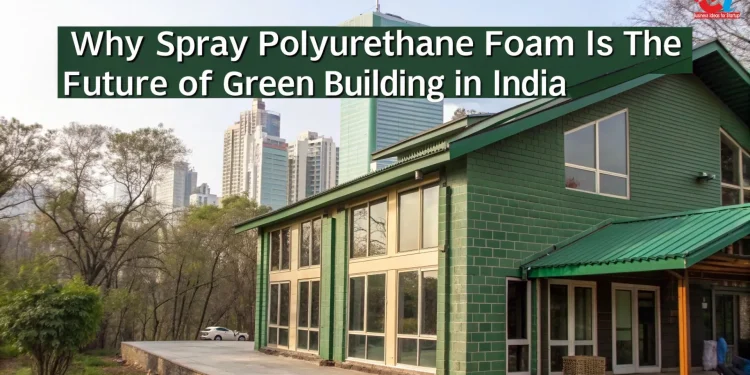With the transition toward sustainable construction techniques and energy-efficient design, building materials are being modified to encompass the added responsibility of an ecological footprint alongside functionality. In this direction, foam materials such as Spray Polyurethane Foam (SPF) have submerged as innovations in insulation and air sealing. SPF is not simply another type of insulation, but rather a novel achievement of technology fully supportive of the themed global focus around green building and net-zero energy edifices.
Spray Polyurethane Foam continues to redefine thermal insulation for residential houses, commercial buildings, and even for use in retrofitting aged infrastructures. It offers a remarkable solution of forming barriers, intricate gap filling, and energy retention, marking it as a vital aspect of construction.
The purpose of this article is to examine the science of polyurethane foam, the applications and benefits of SPF in building constructions, its contributions toward green certifications and the strategic advantages it holds for the manufacturers, contractors and developers in the expanding green economy.
Knowing About Polyurethane Foam with Emphasis on its Spray Polyurethane Foam Type
Polyurethane foam is a highly flexible polymer produced via the reaction of isocyanate and polyol compounds. Depending on the formulation, the resulting foam may either be a rigid or a flexible one. Due to its low thermal conductivity and high structural integrity, rigid polyurethane foam is commonly used in insulation applications.
Specialized application of polyurethane foam is referred to as Spray Polyurethane Foam (SPF) which comes in the form of a spray. Upon contact with surfaces, it expands vigorously, and upon curing, SPF turns into a seamless, durable, and highly insulating layer. Open-cell and closed-cell foams are the two main types of Spray Polyurethane Foam.
While open-cell SPF is lightweight with greater flexibility and is used in soundproofing and internal walls, closed-cell Spray Polyurethane Foam is denser, more resistant to water, and superior in R-value thermal resistance, making it useful for roofs, foundations, exterior walls, and even industrial applications.
Insulation envelope construction without the gaps and joints that form thermal bridges is the monolithic feature of SPF. It is this capability that differentiates SPF from conventional materials used for insulation such as fiberglass, mineral wool, and EPS panels.
Reason Why SPF is Preferred for Insulating Green Buildings
One of the key aspects of green building design is attempting to conserve as much energy as possible. Heating and cooling typically consumes a major portion of a building’s energy, particularly for regions with extreme temperatures. SPF performs exceptionally well as a heater and an insulator which drastically decreases thermal transfer reducing HVAC energy consumption and associated costs.
Unlike traditional insulations, which may shift or compress over time, Spray Polyurethane Foam bonds to surfaces which guarantees performance throughout a building’s life cycle. It is two times more effective than other insulations as it both acts as an insulator and air barrier which aid in mitigating moisture ingress, improving indoor air quality, and preventing mold growth.
SPF closed-cell foam has additional synergistic benefits such as added structural strength, elevated resistance to wind uplift, and improved durability of the building. These factors contribute to the building’s lifespan, decreased maintenance costs, and the underlying philosophies of sustainable construction.
In addition, Spray Polyurethane Foam applications help minimize material waste since the foam expands and fills the gaps of irregular geometries, optimizing the use of raw materials and reducing offcut waste.
Related: Polyurethane (PU) Foam Production and Market Demand
Spray Polyurethane Foam and Green Building Certifications
Polyurethane foam insulation SPF also contributes significantly to the green building rating systems such as LEED, IGBC, and GRIHA. SPF contributes to several credit categories which include energy consumption, indoor air quality, innovation and design, as well as building envelope effectiveness.
Several SPF systems are being designed with zero ozone depleting blowing agents and low VOC emission, making them compliant with some of the most rigorous environmental and health requirements. Manufacturers tend to focus more on life cycle assessments (LCA), which enables them to prove that SPF assists in achieving the green building’s overall sustainability goals.
These enhancements together with the increased focus on green procurement and sustainable supply chains improve the attractiveness of SPF among construction and green building consultants. Also, some product lines are failing in the ozone layer by integrating renewable materials such as bio-based polyols which increase the eco-friendliness of SPF.
Use Throughout Construction Divisions
Besides having applications in new construction, Spray Polyurethane Foam is also effective in retrofitting and rehabilitating older existing structures to enhance their energy performance. In urban areas, where renovation work is more frequent than new builds, SPF makes insulation improvement in difficult-to-access gaps, crawlspaces, and roof decks quick and simple.
In residential buildings, SPF is used in insulation of attics, rim joists, filling cavities within walls as well as under floors. This ensures that the home bounded thermally and air-tight structure. With these, homeowners enjoy reduced energy bills, better thermal stability indoors, and improved acoustics.
In commercial and industrial buildings, SPF is used to insulate roofs, metal buildings, cold storage facilities, and tank exteriors. Its superior resistance to water penetration and ability to provide an airtight weatherproof seal adds to its value when used in flat roof applications and exposed surfaces that require simultaneous insulation and waterproofing.
SPF is now also used for agricultural purposes including barn insulation, grain silo coating, and controlling the climate of greenhouses. The product’s unique ability to withstand moisture, temperature changes, and pest exposure makes it useful in rural construction and agro-processing infrastructure.
Problems with the Adoption of Technologies and the Way Forward
The application of SPF in construction has been slow in some areas due to high initial costs, a lack of awareness, and the unavailability of skilled workers. This is linked to the fact that the first expenditure for SPF is higher than that of its traditional counterparts, thus having a greater long-term value.
Contract SPF training and architectural design strongly influence the acceptance of a new technology. Adoption SPF is expected to steepen as more professionals learn its benefits. SPF’s benefits are becoming more obvious with increasing energy costs and stricter sustainability policies.
Specialized equipment and trained technicians are required for proper implementation of SPF. Improper installation can cause health concerns due to incomplete cures. Hence, certified applicator networks and standard operating procedures are critical components of SPF.
Assistive policies like energy codes, building efficiency standards, tax incentives for insulation improvements, and other forms of ancillary support will also have an impact on boosting demand in the SPF market. Furthermore, government-sponsored education initiatives for green construction materials and programs aimed at retrofitting with high-performance insulating materials could encourage expanded usage.
India’s Construct and Prefabricated Market Opportunity with Polyurethanes Insulation Foams
With intense urbanization, infrastructure upgrades, and a shift towards climate-ready buildings, India’s construction sector is undergoing significant change. The country’s ECBC (Energy Conservation Building Code) paired with green certification programs seem to incentivize builders towards installation of modern insulation systems.
Because of the country’s varying climatic conditions—harsh winters in the north, high humidity in the south—SPF presents itself as a multi-solution insulator. Furthermore, the increasing adoption of modular and prefabricated construction in tier 1 and tier 2 cities is in scope with the ease and speed of installation that SPF provides.
For existing manufacturers or start-ups in polyurethanes foam, there is a perfect case to pursue localization strategy to lower costs while providing bundled design consultation, supervised application, energy audit services, and many more. Those that can deliver comprehensive SPF systems including material supply and on-site application will have the highest gains in India’s evolving green construction market.
Conclusion: Polyurethane Foam as the Backbone of Tomorrow’s Buildings
As construction moves toward smarter, greener, and more energy-conscious practices, polyurethane foam, particularly in spray-applied form, is fast becoming the material of choice for next-generation insulation. Its ability to combine thermal performance, air sealing, moisture control, and structural integrity makes it an all-in-one solution that meets the most demanding standards of green building design.
For builders, developers, and sustainability consultants, SPF is not just a premium alternative—it’s a future-proof investment. As the demand for climate-responsive buildings grows, those who integrate polyurethane foam early into their insulation strategies will enjoy better building performance, occupant comfort, and long-term operational savings.
The future of seamless, high-performance insulation is here—and it’s built on the strength, efficiency, and adaptability of polyurethane foam.Niir Project Consultancy Services (NPCS) provides complete business plans, technical feasibility reports, machinery assistance, and market analysis for polyurethane foam-based insulation ventures.


























